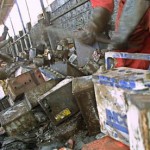Thu 25 Oct 2012
Hygienists! Our job is not done
Posted by admin under Air Monitoring, Asbestos, Behavior Based, Biological Monitoring, Carcinogen, Chemical Exposure, Dermal, Engineering Controls, Exposure, Hazard Communication, Hexavalent chromium, industrial hygienist, Lead, Management, Personal Protective Equip (PPE), Respirators, Safety Programs, Stainless Steel, Training, Welding
1 Comment
You already knew it. There is a lot to do in industrial hygiene. At times this occupation feels like a safety middleman trying to keep people out of trouble. Occasionally I’m rewarded with really helping someone. In the United States, there is still a lot of occupational hygiene issues and concerns. Overseas, particularly in developing countries, there is even more.
It is hard to obtain accurate exposure data, or illness rates, from these underdeveloped countries. (How does a village of 1,000 people in Kenya report that they’ve had lead exposure to battery recycling?) How these exposures are brought to light is by either a massive death (# of people, quickly) or, someone with a camera able to actually photograph the pollution. As we know, what it looks like doesn’t necessarily correlate with hazardous levels of exposure. But, in some cases, it’s pretty obvious.
I ran across this photo story on pollution (The Guardian, UK).  They estimate 125 million people are exposed to industrial pollutants (generic term, I know). This makes occupational related exposures a health risk as big as TB and Malaria! The article is based upon a report from the Blacksmith Institute which included this map of the worst pollution with associated disease.
They estimate 125 million people are exposed to industrial pollutants (generic term, I know). This makes occupational related exposures a health risk as big as TB and Malaria! The article is based upon a report from the Blacksmith Institute which included this map of the worst pollution with associated disease.
How does this apply to construction? The worst offenders are lead (Pb) (and other metals), and asbestos.
What can you do? Here’s their recommendation, from the report (p50):
Developing countries need the support of the international community
to design and implement clean up efforts, improve pollution control technologies, and provide educational
trainings to industry workers and the surrounding community
Another NPR article about lead poisoning can be found here.

One Response to “ Hygienists! Our job is not done ”
Trackbacks & Pingbacks:
[…] To give an example, look at what happened in Bangladesh on November 24/25, 2012. Meanwhile in the US, we were watching football and eating leftover turkey. Â Over 100 people died due to safety concerns that turned into a fire. This country is going through what the US experienced pre-1970. Other countries have similar problems. […]